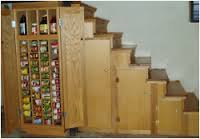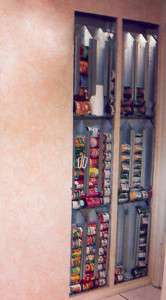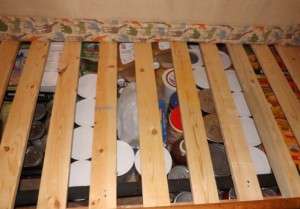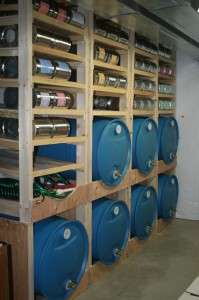Which places to store emergency food do you use?
You've been taking time to gradually build up your canned food storage, but now you've run into a problem: you've reached critical mass! The amount of storage you have (or need to have) exceeds the amount of available space in your home. Where's it all going to go?
The answer is as unique as your personal preparedness plan. Here are a few ideas that will help you find a place for all that food.
1. In the Ground
Sometimes, the best place to store emergency food is where it came from in the first place. Plants like carrots, potatoes, and radishes can be left in the ground over the winter and pulled up as needed. Just make sure your local critters have started hibernating for the winter first!
2. Building Food Racks
A very popular way to store emergency food is to keep it on racks. This has numerous benefits over simply piling it up:
Your food will be easier to store and access
You’ll be able to easily see what supplies you need to restock
Depending on how you construct your storage racks, it’ll be easily to cycle through your food storage and keep it fresh
How about having food racks like this? Survivalist living doesn’t seem so bad! Source: http://waterstoragerack.blogspot.com/
There are lots of different systems and methods for building (or buying) food storage racks in your home, so there’s plenty of room for personalization.
How about having food racks like this? Survivalist living doesn’t seem so bad! Source:
http://waterstoragerack.blogspot.com/
3. Cabinets
A very popular choice to store emergency food is to use cabinets. Though installing these takes a little more time, money, space, and planning than racks, cabinets do have a few added advantages.
First, they're usually more attractive than having your food storage sitting out (although if you have a dedicated pantry for emergency supplies, this isn't an issue).
Second, if you live in an earthquake prone area (such as Southern California), a closed cabinet will prevent your food from rolling off if there's a major earthquake. You don't want to have broken glass preventing you from safely accessing your food!
If you do go the cabinet route, remember that you need space to open your cabinet doors. Sometimes a rack is the better choice. Evaluate your personal situation and decide for yourself.

4. The Space Between Your Studs
If you own your home (as opposed to renting), you’ve got a ton of space that’s relatively unused. Those of you in the mood for a project can store emergency food in the spaces between your studs. That’s right: the very walls of your home will provide your family with protection from emergencies.

To get instructions on how to install these in-wall storage racks, click here.
5. Under Your Furniture
Finally, you may be sitting on a treasure trove of space and not even realize it. Your couch, beds, and other furniture could have enough space underneath to store emergency food.
Sometimes, such as in the case of the couch, you may need an extra inch or two of space above the floor to securely store food. Simply adding some spacers to the bottom of your couch legs will allow you to raise it just enough to place you canned storage underneath.

For more furniture storage ideas click here
Do you have a favorite place to store your emergency supplies we didn’t mention? Please share it with us by leaving a comment!









A few other places that I really like: if you have suspended ceilings in your home, you may have space above that ceiling; my home has suspended ceilings in the basement, and I’ve created shelving above the ceiling between the joists; a couple 3/4″ cleats attached to the bottom of the joists provides a “lip” on which you can set plywood or particle-board shelves; you have 8-10″ of vertical storage space. I’ve also done these shelves in exposed joists:
[IMG]http://i60.tinypic.com/2eqdw10.jpg[/IMG]
[IMG]http://i60.tinypic.com/20shymc.jpg[/IMG]
Another place that is typically unused is the space above closet doors on the inside of the closet. Put a shelf up there and you’ll be surprised at how much storage space you can “create.” I also have shelves above the doors in my attached garage.
Bookshelves are usually built 12″ inches deep when most books are only 8″ deep. You can store oil, salt, dish soap and many other things behind your books and no one will ever see them.
Assemble canning shelves so that the bottom shelf is high enough to slide a tray under it with pint jars and you get an “extra” shelf free. Edsal makes shelves especially to hold canning and you can assemble them lip side up to keep the jars from sliding off.
Add a shelf about 9″ high along the bottom of closets and you can store # 10 cans or quart jars.